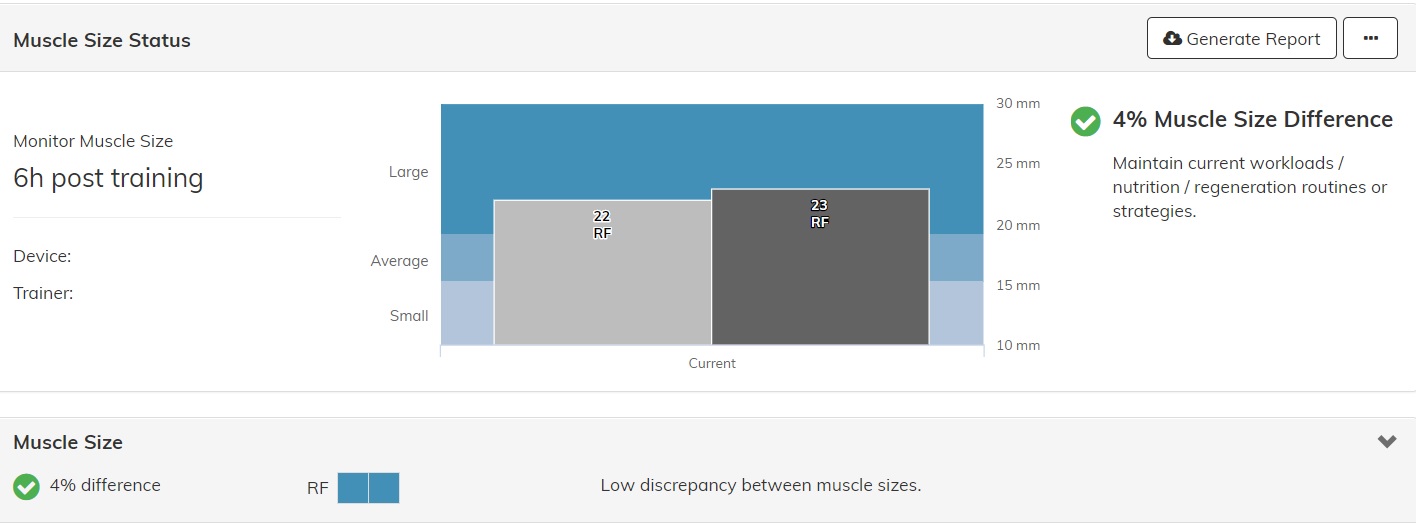MuscleSound is excited to announce it is now able to offer a Muscle Size Assessment which gives the ability to monitor and track changes in this measure at any time during a training or rehab program. Muscle Size is an important, but often underrated, aspect of MuscleHealth at any age and functional status and it is important to many different groups of people.
Muscle Size Overview
Muscle Size is considered as the thickness of a muscle as measured by ultrasound at predetermined muscle locations. Research has shown that Muscle Thickness can be considered a surrogate for Muscle Mass, particularly in the lower limbs.
At MuscleSound we are currently able to assess the size of the thigh muscle, both Rectus Femoris (RF) and Vastus Lateralis (VL). Future assessments will include the Hamstrings (HL) and the Calf/Gastrocnemius (GS).
Why is Muscle Size Important?
Skeletal muscle has a little known, but important, impact on a range of health issues. It is a unique and extensive body tissue that on average makes up approximately 40% of body mass. While it is typically only thought of as having a physical, movement-oriented role, in reality, the skeletal muscle system is fundamental to life. It contributes to crucial health-related functions including breathing, protein metabolism, digestion, blood circulation, immune system status, blood glucose regulation, and overall quality of life.
The size of our muscles, therefore, is an important component of the health of our muscles (our “MuscleHealth”) and makes an essential contribution to well-being at any age and any level of fitness and mobility. However, muscle mass decreases on average by as much as 10% per decade between 30 and 70 years of age and up to 15% per decade thereafter. Therefore, knowing Muscle Size can provide important information on:
- Sarcopenia: the age-related process of muscle mass loss during aging. Something that happens to everyone!
- A muscle’s response to different strength, exercise, and nutrition interventions.
- The symmetry of muscle size in contralateral limbs. This measure can act as an early warning for potential event-related injury risk.
Muscle Size In Health Care
There is increasing awareness that slowing the age-related decline in muscle mass can reduce the risk of a range of chronic health conditions. This is particularly important in older, more frail populations. For example, loss of muscle mass is an important determinant of survival in cancer and cardiac disease patients. By far the greatest muscle-related health risk, however is “Sarcopenia”, the clinical term for loss of muscle mass that occurs as a natural part of the aging process (‘Sarco-’ = ‘Flesh’, -’Penia’ = ‘Poverty’). It is a health- and age-related condition, now regarded as the single most frequent cause of late-life disability.
Muscle Size In Fitness
Muscles clearly underpin physical performance in Fitness and Sports. An increase in Muscle Size (hypertrophy) has long been accepted as one of the prime determinants of “success” for weight lifting/resistance training programs. In addition, muscle size has been associated with a range of performance-related benefits, including greater muscle strength, enhanced speed and power, and increased bone integrity. In addition, assessing contralateral Muscle Size Symmetry, as mentioned above, can provide an early – and easily acquired – injury risk “heads up” for coaches and trainers, compared to more traditional, time-consuming assessment measures.
While loss of muscle is ultimately inevitable with aging, the speed of such losses can be delayed and even transiently reversed with appropriate interventions such as strength training. The key to achieving this, however, is the ability to easily monitor such changes.
Quantifying muscle mass has, until now, required expensive, complex and relatively inaccessible equipment such as MRI, DEXA or BIA. MuscleSound, in contrast, is a rapid, convenient and comfortable method of determining muscle size. Results can be downloaded within seconds for later analysis or historical context. More details of Muscle Size – and other assessments – can be found on the MuscleSound website www.musclesound.com
To see the Monitor Muscle Size Assessment in Action, click here
Selected Resources
Abe, T., et al. Ultrasound assessment of hamstring muscle size using posterior thigh muscle thickness Clin Physiol Funct Imaging 36: 206–210, 2016
Ogawa, M., et al. Ultrasound Assessment of Adductor Muscle Size Using Muscle Thickness of the Thigh. Journal of Sport Rehabilitation 21: 244-248, 2012
Wolfe, R., The underappreciated role of muscle in health and disease. Am J Clin Nutr 84: 475–82, 2006.
Malafarina V, et al., Sarcopenia in the elderly: Diagnosis, physiopathology and treatment. Maturitas 71: 109–114, 2012.

